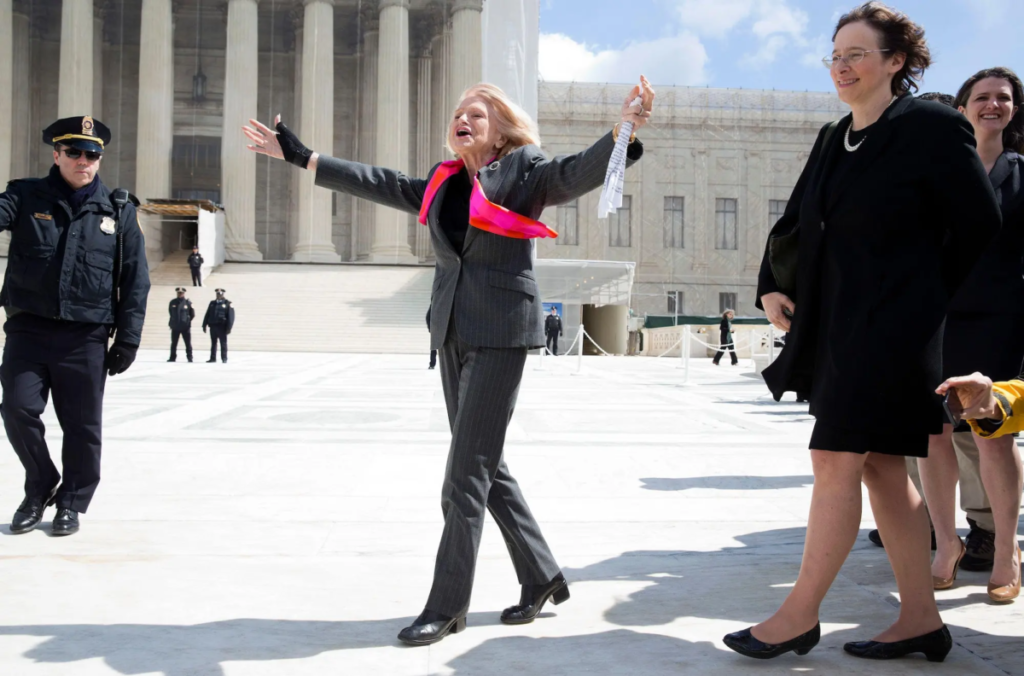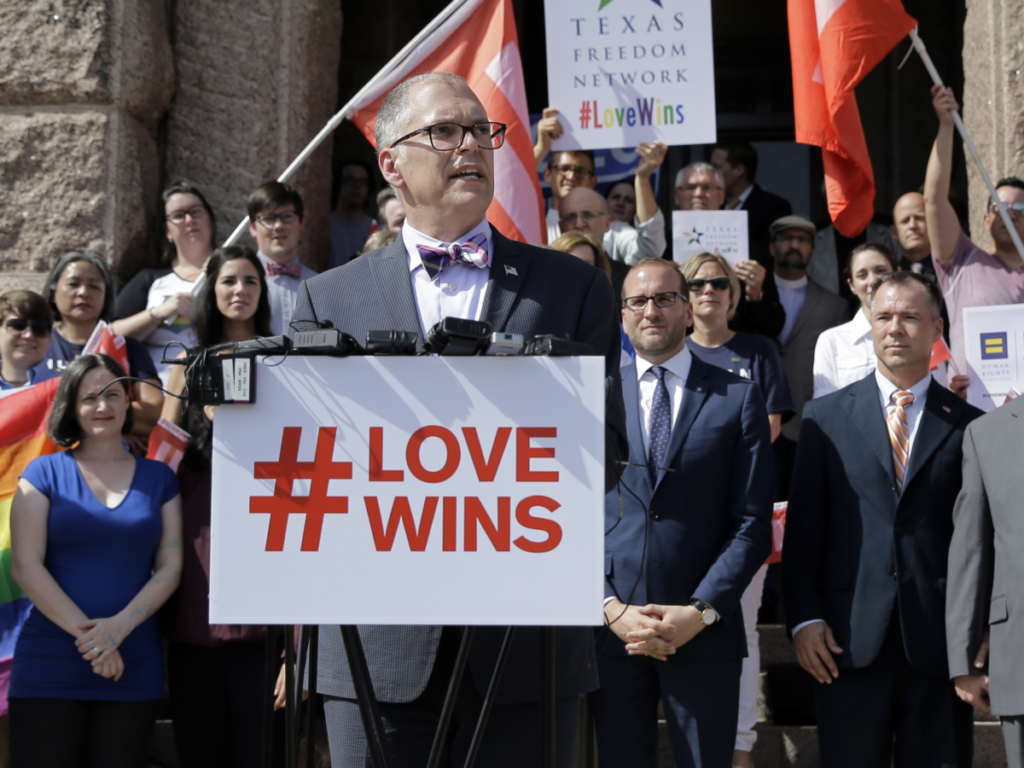
“Married is a magic word. And it is magic throughout the world. It has to do with our dignity as human beings, to be who we are openly.” — Edith Windsor
Overview
Same-sex marriage, also known as Marriage Equality, refers to the legal recognition and authorization of marriage for same-sex couples and LGBTQ+ individuals. The journey towards same-sex marriage legalization and recognition has been a big factor in equality and civil rights movements across the world. This wiki entry will explore the centuries of history of same-sex couples, the court cases that led to same-sex marriage legalization, same-sex marriage outside of the United States, and the impact that legalization had on LGBTQ+ health around the country.
History/Background
In the early 1970s, a burst of gay activism was unleashed by the Stonewall riots in Greenwich Village and many same-sex couples demanded marriage licenses through lawsuits, but the court did not take these cases seriously. Additionally, during this time marriage equality was not a priority for gay activists since they were entirely focused on equality and decriminalizing same-sex relationships. In the late 1980s, the AIDS epidemic emphasized the vulnerability of LGBTQ+ individuals, and that led activists to begin seeking legal rights for same-sex relationships and marriages. However, according to Harvard Law Today, in the late 1990s, roughly 75% of Americans were still unsupportive of same-sex relationships and deemed homosexual sex immoral, 29% supported gay adoptions, and only 10% supported same-sex marriage. Not a single law in support of marriage equality was implemented in the world
When Gay couples in Hawaii started challenging marriage regulations in the early 1990s, the topic of same-sex marriage gained extreme attention around the country. However, the majority of Americans still opposed gay marriage and public opinion was generally still against it. Taking advantage of this issue, the republican party used this to unite religious conservatives and gain more voters during the elections. They proposed several legislations to refuse any recognition to gay weddings that were legally performed anywhere else.
When the Vermont Supreme Court declared in 1999 that the state marriage rules discriminated against same-sex couples, several Americans were furious. A civil unions bill was passed by the Vermont government and it started sparking more and more political unrest and controversy. Various local and national politics became involved in the conversation of the “homosexual agenda.”
Motivated by Vermont’s Supreme Court, activists in Massachusetts filed a lawsuit in 2001 which resulted in the historic 2003 decision to recognize same-sex marriage in the state. However, President George W. Bush supported a federal constitutional amendment that defined marriage as between a man and a woman only, which led to a lot of controversy around the country. Republicans pushed for the referenda in 13 states in 2004 to uphold the conventional definition of marriage, and they were all unfortunately approved. Over the next 10 years, 10 more states approved constitutional amendments outlawing same-sex unions. And from 2006-2007, several high courts in states like Maryland, New Jersey, New York, and Washington denied homosexual marriage, swayed by the backlash from the Massachusetts verdict
Despite all the various political opposition to gay marriage, public support for LGBTQ+ rights grew. The percentage of Americans who knew or identified as gay grew and this statistic indicated a rise in support for gay rights, especially same-sex marriage. Over time, support for allowing LGBTQ+ individuals to serve in the military and have equal legal rights all rose.
Pop culture was another big factor that contributed to the acceptance of homosexuality. As gay characters and plots began to have a reoccurrence on television, awareness of LGBTQ+ individuals increased. This led to more LGBTQ+ individuals coming out due to the growing acceptance around them. Normally, this increased the support of gay marriage across the country at a rapid pace. Since more young people were raised in more accepting communities than their elders, they grew more accepting of gay marriage. And despite all the legal challenges against gay rights, they led to a more positive impact over time by increasing the importance of the topic. More and more public perception of marriage equality started to change as more and more same-sex couples got married and led regular lives.
High courts in Connecticut and California ruled in favor of gay marriage in 2008; However, proposition 8 reversed the California ruling. Despite all of the growing support, proponents of gay marriage were still just short of the majority despite their growing popularity. However, marriage equality took a big step forward in the spring of 2009 when same-sex marriage was approved by the Iowa Supreme Court. Following Vernmont’s lead, New Hampshire and Maine passed laws legalizing same-sex marriage. Furthermore, other states kept moving towards legalizing same-sex marriage. It was implemented in New York in 2011; in 2012, similar laws were implemented in Washington, Maryland, and New Jersey. The support for gay rights from these states resulted in a dramatic shift in popular public opinion.
In December 2012, The Supreme Court agreed to review lawsuits against California’s Proposition 8 and the Defense of Marriage Act (DOMA). This was the big step that resulted in various protests and Supreme Court cases. Ultimately, the decisions of these court cases led to the landmark decision to legalize same-sex marriage in the United States.
Examples
United States v. Windsor
United States v. Windsor was a landmark Supreme Court case regarding same-sex marriage in the US. The case revolved around the “Defense of the Marriage Act” (DOMA), which defined marriage as a union between a woman and a man. Since various states in the U.S. had yet to legalize same-sex marriage, it denied any federal recognition and benefits to same-sex couples who were legally married in their states. Ultimately, the court decided that section 3 of DOMA was unconstitutional and was a violation of the 5th Amendment “Due Process Clause” which explicitly states that “no one should be deprived of life, liberty or property without due process of law.”
Lesbian couple, Edie Windsor and Thea Spyer Wed in New York in 2008, however, Windsor’s wife Thea, died a year later due to decades of struggling with sclerosis. After Thea’s death, their marriage was unrecognized by the federal government which led to Windsor being taxed on the inheritance that she received after Thea’s death. This angered Windsor because according to the federal tax law, once a spouse dies, they can leave their assets to their other spouse without any extra estate taxes. New York ultimately recognized Windsors and Thea’s marriage, but because of DOMA, the federal government refused to treat same-sex married couples equally.
Ultimately, Windsor challenged the “Defense of the Marriage Act” (DOMA) and also sought a refund of the taxes she was forced to pay after her wife’s Death. Besides DOMA violating the 5th amendment, she also argued that DOMA violates the equal protection principles of the United States Constitution because it recognized and respected all existing straight marriages but it completely denied recognition of the existing same-sex marriages, despite the fact that New York treats all marriages equally.
On December 12, 2012, the Supreme Court agreed to hear Windsor’s challenge against DOMA. On June 26, 2013, the United States Supreme Court ruled that the “Defense of Marriage Act” (DOMA) was unconstitutional and that the U.S. government cannot discriminate against married same-sex couples for the purpose of determining any federal protections and benefits.
The United States v. Windsor decision marked the first time the United States recognized same-sex marriages.

Obergefell v. Hodges
Obergefell v. Hodges was one, if not, the most important case for LGBTQ+ Civil rights in the United States. This was another landmark decision made by the Supreme Court of the United States which ruled that the fundamental right to marry is legalized and guaranteed for all same-sex couples across the nation by both the Due Process Clause and the Equal Protection Clause of the 14th Amendment. This required all 50 states to recognize and perform marriages between same-sex individuals and to provide them with equal conditions, benefits, and rights as straight couples.
James Obergfell and John Arthur were a gay couple from Ohio who wanted to get married but were unable to do so as their state of Ohio, just like many other states at the time, illegalized same-sex marriage. At the time, Arthur was suffering from a terminal illness, so they decided to fly out to Maryland to get married since they were unable to do so in their home state. While preparing for Arthurs’s death, Ohio prevented Obergfell from being recognized as Arthurs’s spouse on his death certificates, so they filed a lawsuit challenging the state’s refusal to recognize same-sex marriages on death certificates.
Between January 2012 and February 2014, the case went from court to court all over the country, and on its road, plaintiffs from Michigan, Ohio, Kentucky, and Tennessee filed district court cases that culminated in Obergefell v Hodges. Following several appeals court rulings, on November 14, 2014, Obergefell filed a petition for a Writ of Certiorari with the United States Supreme Court.
On June 26, 2015, the United States Supreme Court ruled the 14th Amendment requires every single state to license marriages between same-sex couples and to recognize all lawfully performed out-of-state marriages. Ultimately, the Supreme Court ruled that all same-sex couples are guaranteed the right to get married and extended recognition all throughout the United States.

Same-sex marriage outside the U.S.
The fight for same-sex marriage legalization has created a big global movement and it has helped improve the rights of LGBTQ+ individuals across the entire world. However, there are still 69 countries that not only have same-sex marriage illegalized but also follow national laws that discriminate against and criminalize any type of same-sex relationship between adults. And in those countries, 6 of them have national laws that criminalize gender expression in order to target transgender and gender-conforming individuals.
The act of punishment for same-sex conduct varies between countries. In some countries, only specific acts are punished while in others the law is more vague on what is allowed and what is not. For example, countries like Saudia Arabia, Egypt, Morocco, Jamaica, Sri Lanka, Barbados, and many more prohibit and criminalize any type of same-sex relations by type of offense. This includes homosexual acts like “sodomy” which is anal or oral sex, “buggery” which is anal sex, “unnatural/indecent acts”, and debauchery. The criminal sentences for these acts can range from 10 years to life. Some of these countries even forbid any type of transgender expression, and laws in places like Oman and Kuwait criminalize and punish “posing” as the opposite sex. However, Mauritania, Yemen, Saudi Arabia, Qatar, Iran, Brunei, and Nigeria still implement the death penalty for any of these acts.
Although several countries around the world have had the courage to create a safe space for their citizens, regardless of their sexual orientation and gender, many still refuse to provide basic human rights like self-expression and marriage to LGBTQ+ individuals in their community.

Health Effects of Same-Sex Marriage
According to David Teller, a writer for Health Affairs, LGBTQ+ individuals experienced the most health disparities and disproportionate rate of negative health outcomes before the legalization of Same-sex Marriage in the United States. Gay men were at a higher risk of contracting HIV, and lesbians were less likely to have access to preventative services for cancer. Based on a sample of US adults in the National Epidemiologic Survey on Alcohol and Related Conditions, they had higher rates of suicide attempts, smoking, alcohol, and drug abuse, especially if the people were from a state that had passed several laws against same-sex marriage and LGBTQ+ individuals.
The changes in laws and social acceptance, especially the legalization of same-sex marriage in 2015, had the potential to positively affect the health of LGBTQ+ individuals in the United States. Early research has found positive health results not just among adults but also among LGBTQ+ teenagers. A recent study compared the rates of suicide attempts in high school students who did and did not implement same-sex marriage laws. Among LGBTQ+ high school students, 29% had a reported suicide attempt in the past year compared to 6% on non- LGBTQ+ students. Implementation of same-sex marriage laws in their state led to a 7% decrease in reported suicide attempts. The lead author of this study, Julia Raifman, says that “simply having equal rights could have made people feel better about themselves and less likely to attempt suicide.
Marriage has also been associated with better health outcomes, such as having better access to federal benefits and health insurance. The impact of increased social acceptance and several federal laws recognizing same-sex couples has been considered a positive factor in the well-being of LGBTQ+ individuals in the United States. Furthermore, it was suggested that marriage contributed to a greater sense of empowerment of the individual.

Works Cited
Chamie, Joseph, and Barry Mirkin. “Same-Sex Marriage: A New Social Phenomenon.” Population and Development Review, vol. 37, no. 3, 2011, pp. 529–51. JSTOR, http://www.jstor.org/stable/23036054
Daniels, R. Steven. “The Evolution of Attitudes on Same‐Sex Marriage in the United States, 1988–2014.” Social Science Quarterly, vol. 100, no. 5, 4 June 2019, https://doi.org/10.1111/ssqu.12673.
Human Rights Campaign. “The Journey to Marriage Equality in the United States.” Human Rights Campaign, www.hrc.org/our-work/stories/the-journey-to-marriage-equality-in-the-united-states.
Tuller, David. “The Health Effects of Legalizing Same-Sex Marriage.” Health Affairs, vol. 36, no. 6, June 2017, pp. 978–981, www.healthaffairs.org/doi/10.1377/hlthaff.2017.0502, https://doi.org/10.1377/hlthaff.2017.0502.
“#OUTLAWED: “The Love That Dare Not Speak Its Name.”” Features.hrw.org, features.hrw.org/features/features/lgbt_laws/?gclid=CjwKCAjwp8OpBhAFEiwAG7NaEtYCPZhTr6up-0DHwGwcuWc9wu181SHeK6b-DMweFE0kI5xfzOJ1oxoCfKYQAvD_BwE. Accessed 20 Oct. 2023.
Staff, HLS News. “How Same-Sex Marriage Came to Be.” Harvard Law School, 13 June 2013, hls.harvard.edu/today/how-same-sex-marriage-came-to-be/.
Wills, Matthew. “The Long History of Same-Sex Marriage.” JSTOR Daily, 2 June 2022, daily.jstor.org/the-long-history-of-same-sex-marriage/.
Library, Reference Law. “A Brief History of Civil Rights in the United States.” Library.law.howard.edu, 6 Jan. 2023, library.law.howard.edu/civilrightshistory/lgbtq/prop8.
“Due Process.” LII / Legal Information Institute, www.law.cornell.edu/wex/due_process#:~:text=The%20Fifth%20Amendment%20says%20to.
“Windsor v. United States.” American Civil Liberties Union, www.aclu.org/cases/windsor-v-united-states.
Gray, Eliza. “Person of the Year Runner-Up: Edith Windsor.” Time, 11 Dec. 2013, poy.time.com/2013/12/11/runner-up-edith-windsor-the-unlikely-activist/.
“Edie & Thea’s Love Story | ACLU of Oregon.” Www.aclu-Or.org, 23 May 2013, www.aclu-or.org/en/edie-theas-love-story-0. Accessed 27 Oct. 2023.
ACLU of Ohio. “Obergefell v. Hodges.” ACLU of Ohio, 16 Jan. 2014, www.acluohio.org/en/cases/obergefell-v-hodges.
Rosenwald, Michael S. “How Jim Obergefell Became the Face of the Supreme Court Gay Marriage Case.” The Washington Post, 6 Apr. 2015, www.washingtonpost.com/local/how-jim-obergefell-became-the-face-of-the-supreme-court-gay-marriage-case/2015/04/06/3740433c-d958-11e4-b3f2-607bd612aeac_story.html.
